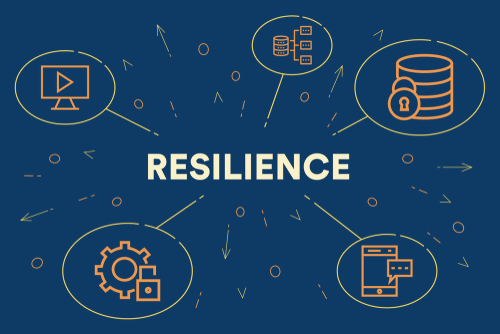There’s a great saying in military circles that’s often summarized as “no plan survives contact with the enemy.” As business leaders in a highly disrupted world, it’s easy to feel that way: hours upon hours of thoughtful strategizing routinely gets blown up by everything from constant geopolitical uncertainty to fast-shifting employee preferences. Even the best leaders experience moments of helplessness: how can I build a resilient organization in an era where chaos seems to reign?
Historically, we’ve just muscled through. Leaders and their teams have toughed it out. But with employee and leadership exhaustion continuing to be felt in the long shadow of the COVID pandemic, it’s both unfair and frankly unwise to rely on individuals to buffer constant disruptions. Instead, the strongest organizations employ a handful of concrete strategies.
Focus Rigorously on What You Can Control
Recently, I conducted a workshop with an executive team where I challenged them to list changing forces in their environment, and to choose the most critical changes they’re responding to. They listed an array of global and economic shifts – but when it came time to choose the most important areas of change, they chose technology and talent, two areas firmly under their control. When I pressed them on why, the executives noted that the outside world is always going to be volatile, but getting those two pillars right was their best hope of coping with that volatility. True discipline around “sphere of concern versus sphere of influence” keeps organizations playing offense to the utmost degree possible – not sitting in reactive mode, responding to every trend and event that shows up at their doorstep.
Minimize Internal Disruption
Today’s most resilient organizations operate as the eye of the storm: a place of calm, trust, and psychological safety, while winds circle outside. Organizational agility doesn’t mean jumpiness; rather, the organizations that can move the fastest are those that feature a minimum of day-to-day agitation. Allowing conflict of ideas to breathe is critical, so frustration doesn’t fester and the best approaches triumph, but by the same token interpersonal conflict must be kept to a minimum. Eliminating toxic leader behaviors, clarifying decision rights, and deploying real-time change management strategies are all crucial steps toward a workplace that has the emotional energy to handle disruption from the outside. For instance, one organization that I’ve worked with grappled with operating in a highly disrupted and suddenly very competitive category by banishing a host of complex organizational structures and processes. They realized that internal back-and-forth was sapping crucial momentum needed to address upstart competitors. If their own employees’ days were simpler, each person on their teams had greater bandwidth to intelligently navigate a disrupted landscape.
Ensure the Technology Journey is Well Shepherded
In a volatile landscape, technology can be an organization’s best friend or worst enemy. Complicating matters, technological change is volatile itself today; for instance, if your technology strategy was framed a few years ago and didn’t include artificial intelligence, you’re probably doing some revising right now. Technology is never going to operate absolutely perfect or stop evolving, so resilient organizations and thoughtful leaders put their focus on proper guidance, governance, and insight around technology. Keeping leaders well-educated about how technology works is often a great first step. After all, bluster to hide lack of insight drives a thousand bad tech decisions which leave organizations vulnerable when the landscape changes, lacking crucial information and being slowed from quick action.
It’s also critical to drive a real dialogue between the IT function and other business leaders, facilitated not just by leadership collaboration but also by the right organizational structures, processes, and change strategies. Technology may not always be exactly what you need when you need it, but with leaders working together properly around it, the technology journey can be more of a source of support than a disruption itself. The dividends may be paid in unexpected ways: I’ve encountered several organizations that did such a good job of engaging employees on upskilling themselves on new technology that those upskilling efforts became a concrete source of employee engagement and retention, driving a smooth path through generally disrupted talent markets.
Keep Both Top-Down and Bottom-Up Channels of Communication Open – You Never Know When You’ll Need Them
Nimble leaders are in a constant dialogue with their organizations: sharing information in a well-framed, transparent manner, and at the same time listening to employees all the way down to the front line to ensure they keep a view on what’s truly happening in the market. It can be easy to get caught up in a dizzying array of other priorities – scheduling a quick town hall here and there as a superficial check-in – but at moments of true disruption, leaders that already have robust communication channels in place are best positioned to both rally their people and importantly, to learn from them in real time. Think back to when COVID hit: was it straightforward for your organization to deliver key messages and figure out what was going on, or was a mad scramble required?
Disruption may be our forever future. But resilient organizations that focus on what they can control, create a calm and sane way of operating, shepherd the technology journey intelligently, and keep two-way channels of communication open have the best possible chance to not just survive, but thrive in a chaotic world.
Melissa Swift is a Vice President and leads the Workforce & Organization practice for Capgemini Invent in North America. She is the author of the award-winning book “Work Here Now: Think Like a Human and Build a Powerhouse Workplace” (Wiley, 2023), and a member of the 2023 Thinkers50 Radar Class. Melissa has a long track record of developing analytically-driven methodologies to better enable the transformation journey, and has partnered with clients on large-scale, innovative workforce and organizational shifts across industries and geographies.


